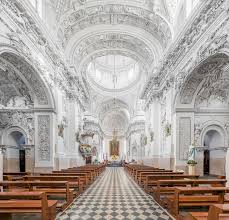Dostoevsky's Crime and Punishment is a tale of many layers, and speaks directly to and from the human heart, calling out a warning to those who separate themselves from divinity, and the morality which it dictates. The story is one which reflects Dostoevsky’s concerns over what Nietzsche calls “the death of God”, and the consequences which he saw as inevitably approaching as a result. Dostoevsky, like Nietzsche, observed that faith in God, and therefore traditional morality, which was predicated upon such faith, was beginning to erode within Russia, and Europe consciousness generally. The protagonist of the novel, Raskolnikov is a representation of such a development, as can be seen in the meaning of his name: he Russian word raskol means schism, and implies an individual who has cut himself off from the church, and thus traditional morality.
.jpeg)
Dostoevsky viewed this new development as having largely been caused by progressive thought, especially science and Enlightenment thinking, which placed emphasis on rationality, dismissing faith as superstition. Throughout the novel, these ideas are voiced by various characters, many of which are confused about them, or unwilling to see that they lead to actions such as those undertaken by Raskolnikov. In fact, the idea that Raskolnikov has, which ultimately leads him to commit murder, is where Dostoevsky believed reliance on rationality and the self-contained individual would inevitably lead. In Dostoevsky’s view, a disbelief in God results in a kind of self-worship, in which “everything is permitted” (Brother’s Karamazov). Without the foundational belief in some kind of divinity, the human being loses all moral value, as there is nothing in which to ground that value. In Christianity, every individual is divine because of their direct relationship with God. Each human being is made by God in the image of the divine, and has the capacity to commune with that divinity, and is therefore holy. Without faith in this foundational principle, at least as Dostoevsky sees it, there is nothing to prevent anybody from pursuing unhindered self-interest. It follows, as portrayed in the ‘idea’ possessing Raskolnikov, that those who constrain themselves within any kind of morality only do so because of their weakness, because they have not recognized their own freedom and broken away from all morality in order to prove their greatness, and thus their right to transgress morality. Ironically, this leads to the transgression of morality in order to prove the right to said transgression, therefore defining greatness via itself, as a self-justifying act.
This sort of diabolical self-reliance is the direction in which Dostoevsky believed the world was going, and he predicted, in Raskolnikov’s illness-induced dream towards the end of the story, that it would result in untold levels of death: “Each thought that he alone had the truth and was wretched looking at the others... They did not know how to judge and could not agree what to consider evil and what good... Men killed each other in a sort of senseless spite.” This prediction can only be said to be correct, at least in essence, when one views the subsequent history of the 20th century. The association between this result, and the progressive ideas which Dostoevsky blamed for generating them, can be seen most clearly in the chosen setting of the scene of Raskolnikov’s describing his murderous actions to the character Zametov, which he does in a restaurant called “The Crystal Palace” named for a structure built in London in Dostoevsky’s life to represent exactly such “new ideas”.

The symbols of this schismatic process, which Dostoevsky associates with a descent, repeat throughout the novel in images such as yellow, water, bells, blood, and threshold. These images swirl around a central theme of descent, and yet carry with them a bivalence suggestive of the possibility of redemption. We might consider them in a specific kind of order as a means of casting light on their significance. The corruption of Raskolnikov begins with his stagnation and excessive contemplation of his “idea”, leading him into a kind of monomania. This process of decay can best be expressed through the reccuring symbol of yellow throughout the novel, as can be seen in the yellowing wall-paper of his room, as well as the yellow water which is present just before his fainting episode in the police station. The image of bells is implied as a forerunner to this state, indicated in Raskolnikov’s moral/religious childhood, and is thus not directly involved in the central narrative, as we are introduced to Raskolnikov at a time when he has already sunk deep into his own corruption. The image following from yellow, i.e. corruption/stagnation, is that of a threshold, as seen in Raskolnikov’s standing on the threshold of the pawnbrokers door, ringing a bell with no sound (another indication that the schism has already occurred), as well as the moment before he commits the crime, and indeed every scene within the book where any character is about to take a plunge into new territory, whether it be off a bridge in a suicide attempt, or into the police station to confess. Thus plunge into the water is itself the next step of this descent, which is tied with the flowing of blood, as in the murder, but also with death generally, as can be seen in the blood coughed up by Katerina Ivonovna once she has been expelled from her home. The blood is not only the death of the pawnbrokers, but of Raskolnikov himself, who cuts himself off from life, and from humanity, by his actions. “Did I murder the old woman? I murdered myself, not her! I crushed myself once and for all, forever... But it was the devil that killed that old woman, not I.”
Conversely, this descent implies the possibility of an ascent, as well, and many of these images have a dual meaning within the text, the most striking of which is the symbol of water. The water is simultaneously the chaos that Raskolnikov plunges into by committing murder, as well as the “water of life”, the possibility of redemption which is also a title of Jesus Christ. This redemptive water is seen most acutely in the appeal to Raskolnikov to “drink some water” while he is in the process of confessing. It is the flood of chaos as well as the flood of life, and therefore the only means of redemption, as Porfiry Petrovich says: “throw yourself into the flood and have it bring you back upon the shores of life”. This image is a repetition of the scene in which Raskolnikov witnesses a girl jump from a bridge in order to commit suicide, only to be saved by a policeman. The water might thus be seen as an image of surrender to forces more powerful than the individual, an understanding that makes intelligible Svidrigailov’s stated hatred of water, “even in landscape paintings”, as he says. Svidrigailov, who is Raskolnikov’s double in the sense of having cut himself away from all morality through his own rationalized justifications, albeit to a much more extreme degree, is unable to give himself up to larger forces, and is therefore cut off completely from the possibility of redemption (“the blood, which was already getting dry, smeared his hand”). His only recourse is to take his own life by a direct and willful action.
Thus it only through a surrender to water, to the larger and potentially redemptive forces that might humble and return him to life through a form baptism, that any possibility of a future exists for Raskolnikov. Yet even once this has been done, it takes time for the effects to work upon him, and for the beginning of his imprisonment he is not much changed, and still feels no remorse. It is only once his pride is shattered, as represented by his illness, which significantly ends shortly after Easter (the celebration of Christ’s resurrection) that Raskolnikov becomes humble enough to be able to come to the light of love, embodied and directed towards Sonia, whose name means “little wisdom”, and is herself a representation of dedication to Christ and morality.
.jpeg)
Salvation in Crime and Punishment, however, is a slow, gradual process, and not something that can necessarily be attributed to the influence of Sonia, or even to any single factor. Despite Dostoevsky’s insistence that love was the cause of his redemption, it is clear that love played only a part in Raskolnikov’s revived humanity, as many forces intersected in order to tear down the pride that had cut him off from his childhood beliefs. It was only through the humility of suffering, and through the symbolic death/baptism of his imprisonment and illness, which Dostoevsky attributes to ‘wounded pride’, that he becomes capable of being open to love, and to redemption.
qood veru help me replay
Downvoting a post can decrease pending rewards and make it less visible. Common reasons:
Submit
Congratulations @benwoollard! You received a personal award!
Click here to view your Board of Honor
Do not miss the last post from @steemitboard:
Downvoting a post can decrease pending rewards and make it less visible. Common reasons:
Submit
Congratulations @benwoollard! You received a personal award!
You can view your badges on your Steem Board and compare to others on the Steem Ranking
Vote for @Steemitboard as a witness to get one more award and increased upvotes!
Downvoting a post can decrease pending rewards and make it less visible. Common reasons:
Submit